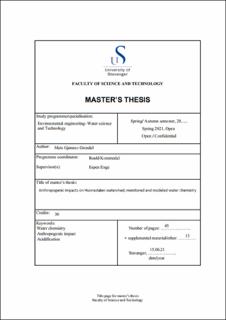| dc.description.abstract | Hunnedalen watershed, in southwestern Norway, are associated with dilute water quality which makes it highly responsive to changes. In this study, the watershed’s water quality was monitored for one year, 2020, to evaluate the anthropogenic effects on the watershed. Anthropogenic effects were found to be neglectable, however simulations demonstrated a marginally improved water quality when the watershed is regulated. The watershed was found to be highly dominated by marine ions, distributed geographically with the altitude. Further, the marine contribution was found to consume alkalinity and lower the pH in the watershed. This decrease in pH was found to mobilize inorganic aluminum. Further, the inorganic aluminum was found to be limited by humic acid and alkalinity.
The low alkalinity and humic acid concentration, especially in the high-altitude area, makes the watershed susceptible to acidification. Therefore, liming is a suggested counter measure to be sure that the fish population survives. | |
